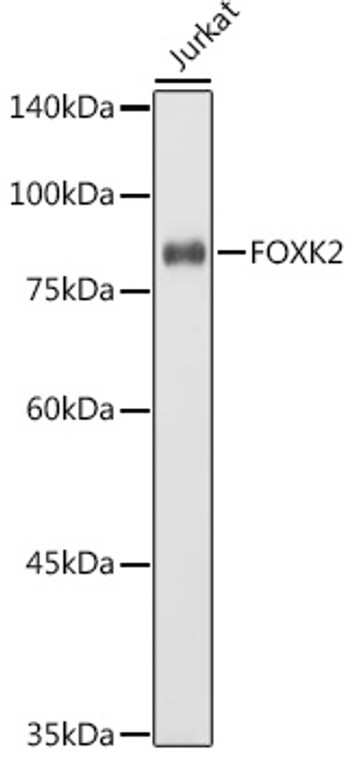| Host: |
Rabbit |
| Applications: |
WB/ELISA |
| Reactivity: |
Human/Mouse/Rat |
| Note: |
STRICTLY FOR FURTHER SCIENTIFIC RESEARCH USE ONLY (RUO). MUST NOT TO BE USED IN DIAGNOSTIC OR THERAPEUTIC APPLICATIONS. |
| Clonality: |
Polyclonal |
| Conjugation: |
Unconjugated |
| Isotype: |
IgG |
| Formulation: |
PBS with 0.05% Proclin300, 50% Glycerol, pH 7.3. |
| Purification: |
Affinity purification |
| Concentration: |
Lot specific |
| Dilution Range: |
WB:1:500-1:1000ELISA:Recommended starting concentration is 1 Mu g/mL. Please optimize the concentration based on your specific assay requirements. |
| Storage Instruction: |
Store at-20°C for up to 1 year from the date of receipt, and avoid repeat freeze-thaw cycles. |
| Gene Symbol: |
FOXK2 |
| Gene ID: |
3607 |
| Uniprot ID: |
FOXK2_HUMAN |
| Immunogen Region: |
360-430 |
| Specificity: |
Recombinant fusion protein containing a sequence corresponding to amino acids 360-430 of human FOXK2 (NP_004505.2). |
| Immunogen Sequence: |
TPLGPLSSRSAPASPNHAGV LSAHSSGAQTPESLSREGSP APLEPEPGAAQPKLAVIQEA RFAQSAPGSPL |
| Tissue Specificity | Expressed in both lymphoid and non-lymphoid cells. |
| Post Translational Modifications | Hyperphosphorylated during mitosis by CDK1 and, to a lower extent, CDK2. Phosphorylation at Ser-373 and Ser-428 affects stability by promoting degradation. |
| Function | Transcriptional regulator involved in different processes such as glucose metabolism, aerobic glycolysis and autophagy. Recognizes and binds the forkhead DNA sequence motif (5'-GTAAACA-3') and can both act as a transcription activator or repressor, depending on the context. Together with FOXK1, acts as a key regulator of metabolic reprogramming towards aerobic glycolysis, a process in which glucose is converted to lactate in the presence of oxygen. Acts by promoting expression of enzymes for glycolysis (such as hexokinase-2 (HK2), phosphofructokinase, pyruvate kinase (PKLR) and lactate dehydrogenase), while suppressing further oxidation of pyruvate in the mitochondria by up-regulating pyruvate dehydrogenase kinases PDK1 and PDK4. Probably plays a role in gluconeogenesis during overnight fasting, when lactate from white adipose tissue and muscle is the main substrate. Together with FOXK1, acts as a negative regulator of autophagy in skeletal muscle: in response to starvation, enters the nucleus, binds the promoters of autophagy genes and represses their expression, preventing proteolysis of skeletal muscle proteins. In addition to the 5'-GTAAACA-3' DNA motif, also binds the 5'-TGANTCA-3' palindromic DNA motif, and co-associates with JUN/AP-1 to activate transcription. Also able to bind to a minimal DNA heteroduplex containing a G/T-mismatch with 5'-TRTG/TNB-3' sequence. Binds to NFAT-like motifs (purine-rich) in the IL2 promoter. Positively regulates WNT/beta-catenin signaling by translocating DVL proteins into the nucleus. Also binds to HIV-1 long terminal repeat. May be involved in both positive and negative regulation of important viral and cellular promoter elements. Accessory component of the polycomb repressive deubiquitinase (PR-DUB) complex.recruits the PR-DUB complex to specific FOXK2-bound genes. |
| Protein Name | Forkhead Box Protein K2G/T-Mismatch Specific Binding ProteinNgtbpInterleukin Enhancer-Binding Factor 1 |
| Database Links | Reactome: R-HSA-5689603 |
| Cellular Localisation | NucleusCytoplasm |
| Alternative Antibody Names | Anti-Forkhead Box Protein K2 antibodyAnti-G/T-Mismatch Specific Binding Protein antibodyAnti-Ngtbp antibodyAnti-Interleukin Enhancer-Binding Factor 1 antibodyAnti-FOXK2 antibodyAnti-ILF antibodyAnti-ILF1 antibody |
Information sourced from Uniprot.org
12 months for antibodies. 6 months for ELISA Kits. Please see website T&Cs for further guidance








